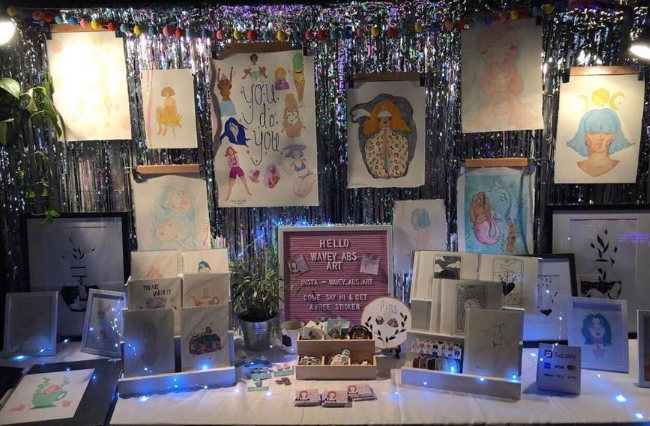There has always been something really special about walking through market stalls in Melbourne, whether that be local artists displaying their pride and joy, the smell of freshly baked goods or the overwhelming feeling of support for local businesses.
However, due to COVID-19, the joy that market-goers experience while engaging in the personable culture is now non-existent. Melbourne-wide, artists are being forced to move their operations solely online or risk losing their business and customers altogether.
The pandemic has drastically changed the way that everyone operates their business. With many sole-traders and freelance artists left out of Federal Government payment schemes, such as JobKeeper, there are concerns that Melbourne’s arts and crafts culture will struggle to stay afloat.
Lauren Cameron (@Wavey_Abs_Art) is a local Melbourne artist, who has visually expressed herself through painting since she was young. Over the last two years, she has pursued her dream of turning her passion into a career.
Cameron has always sold her products online via Instagram and Etsy, but since the closure of markets due to COVID-19, she has had to move all her products online and has recently opened an independent online shop.
“I’ve always really liked selling online. So, I’ve still enjoyed that because I still find it lots of fun, but I am really missing that face-to-face contact that you have with people,” she told upstart.
As COVID-19 propels more sellers to trade virtually, online sales have increased significantly as a result.
According to Australia Post’s 2020 eCommerce industry report, Inside Australian Online Shopping, eCommerce growth is up 80 percent year-on-year, with over 200,000 new shoppers entering the online market in April 2020.
The growth in online stores and sales means that the need for a unique social media presence to attract customers and drive sales is more important now than ever before. Recent trends on Instagram like #supportlocal and #supportlocalartists are also gaining traction and drawing attention to small businesses that are doing it tough.
Cameron has been using Instagram for the past two years to develop her brand and engage with creative minds; however, the process hasn’t always been easy.
“The biggest challenge with Instagram was learning and figuring out the quality of my posts and getting enough traction to those posts, learning the exact right hashtags that you need, the quality of your photo, what work your posting,” she said.
“It’s frustrating just because of what people want to see on Instagram.”
Fortunately for Cameron, the opening of her online shop on 13 July 2020 was accompanied by new and eager customers, receiving over 30 orders of ceramic goods on the first day of trading.
“When I started packaging all the orders, it was just the most relaxing thing ever to watch all the boxes pile-up,” she said.
The same can’t be said for all Melbourne artists and small business owners. Since the introduction of stage four lockdown restrictions in Victoria, local markets have once again had to close-up shop.
Laura Deakin, founder of Coral Covey, is a Melbourne-based designer specialising in handmade, sustainable jewellery. Deakin usually frequents the Rose St Artist’s Market in the heart of Fitzroy, which is home to up to 120 creatives, selling unique, handmade works of art.
Since Rose St’s closure, Deakin has struggled with transitioning to solely online trading, finding that communication is the main problem.
“A core part of my business is in talking to clients in person about custom work, like wedding rings, and this is almost impossible online,” Deakin told upstart.
“Although I have had some online sales, these don’t compare to the in-person transactions.”
Rose St market director Christian Ferrante is fortunate enough to have a well-established virtual presence in which stallholders, like Deakin, can continue to operate, but the pandemic has certainly taken a toll on this once thriving industry.
“We’ve had an online platform for years, so the template has always been there. However, the main change has been the focus on promoting online versus actual attendance at the event,” he told upstart.
There are thousands of artists and creatives around the world, with over 48,000 practicing professionally in Australia, therefore the need to stand out from the crowd is something that is always at the back of an artist’s mind.
Now with the online space seeing a rise in retailers, the competitive nature of this industry has increased. Ferrante has noticed that one of the biggest challenges with selling solely online is attracting an audience.
“It is difficult to convey the uniqueness and quality of the handmade products being sold on an online platform. Also, as the transition to online has been industrywide, there’s increased clutter and competition in the marketplace,” he said.
Despite the rise in competition, the online spaces available to creatives as well as the power of social media is giving hope to artists and designers that there will be a prosperous and colourful industry to return to post lockdown. While Lauren Cameron is grateful that she can still reach customers online, it doesn’t stop her from looking forward to the day markets reopen again.
“I just wanna [sic] sit there with my cup of tea and be really awkward when people ask me questions about my artwork, I can’t wait to get back to selling face-to-face,” she said.
Article: Aisling O’Mahony is a third-year Bachelor of Media and Communications (Media Industries) student at La Trobe University. You can follow her on Twitter @AislingOMahony.
Photo: Supplied by Lauren Cameron.







